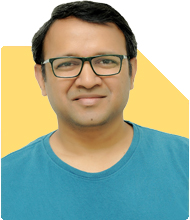43+ with 3.2 L Salary Looking to Create 8-10 Cr by Retirement: Right SIP Investment Strategy?
Ramalingam Kalirajan |10899 Answers |Ask -Follow
Mutual Funds, Financial Planning Expert - Answered on Jul 15, 2024
He has an MBA in finance from the University of Madras and is a certified financial planner.
He is the director and chief financial planner at Holistic Investment, a Chennai-based firm that offers financial planning and wealth management advice.... more

Hi Sir, I'm 43+, Monthly take home is around 3.20 Lacs, Currently i have invested in Shares (Current Portfolio is around 1.75 Crs). EMI is around 1.1 lacs P/m (Home loan 1 - 50K per month till 2037, 30K car loan till 2027 (Planning to close this year by paying 12 lacs, please suggest if this option of preclosure is good or EMI is good), 30k per month of home 2 till 2040., Recently i have started investing in SIP 1 lacs P/M, and balance 1.20 lacs goes in house, kids education expense. Have EPF balance of 40 lacs as on date. As mentioned above recently i have started investing in SIP (From Oct 2023 onwards), which is at the tune of 1 lacs per month. SIP are Franklin India Prima Fund regular Plan - Growth - 25K, ICICI Prudential Small cap fund retail plan G - 25K, Kotak Multicap fund regular plan growth - 15K, DSP Blackrock mid cap fund regular plan growth - 10 K, and Parag Parikh Flexi Cap fund - Regular plan growth - 25 K. Will increase the SIP investment by 10% every year going forward. Sir, My question is with current SIP investment will i be able to generate 8~10 Cr corpus fund by retirement (Assuming that i will be in Job and working for next 15 years). Current Share portfolio is for long term investment only (assuming i get 12~15% of return every year). Please note : will be spending around 80 lacs for my Son education in engineering from 2027 to 2031, 50% will be spend from savings and balance 50% from education loan.
Current Financial Overview
Income and Expenses
Your current monthly take-home income is around Rs 3.20 lakhs. This is a healthy income, providing you with a good foundation to build your investments. With an EMI burden of Rs 1.1 lakhs per month, you have a significant portion of your income allocated towards debt repayment. It is essential to manage this debt efficiently to maximize your savings and investments.
Investment Portfolio
Your current investment portfolio is diversified across shares, SIPs, and EPF. Here is a quick breakdown:
Shares: Your long-term share portfolio is valued at Rs 1.75 crores.
SIPs: You have recently started SIPs of Rs 1 lakh per month across various funds. This is a positive step towards systematic investment.
EPF: Your EPF balance is Rs 40 lakhs as of now.
EMI Obligations
You have three major EMIs:
Home loan 1: Rs 50,000 per month till 2037
Car loan: Rs 30,000 per month till 2027 (with a plan to prepay Rs 12 lakhs)
Home loan 2: Rs 30,000 per month till 2040
Other Expenses
You have also accounted for household and educational expenses, which is Rs 1.20 lakhs per month. This ensures your family’s needs are met while you invest for the future.
Investment Strategy
SIP Investments
Your SIP investments are well diversified across different types of funds. This diversification helps in managing risks and achieving steady growth. Increasing SIP investments by 10% annually is a prudent strategy, ensuring that your investments grow with your income.
Long-term Share Investments
Assuming a 12-15% return per annum from your share investments, you are on a good path. Shares, being long-term investments, have the potential to provide significant returns, especially if chosen wisely.
EPF
Your EPF provides a secure and stable return, acting as a safety net for your retirement corpus. It is crucial to continue contributing to this fund as it offers tax benefits and compounded growth.
Debt Management
Prepaying Car Loan
Prepaying the car loan of Rs 12 lakhs can be a good decision. It will reduce your EMI burden by Rs 30,000 per month. With the car loan closed, you can redirect this amount towards your investments, accelerating your wealth creation.
Home Loans
Your home loans have a longer tenure, and given their current interest rates, it is advisable to continue with the EMIs. Home loans also provide tax benefits which should be considered.
Future Financial Goals
Retirement Corpus
To achieve a corpus of Rs 8-10 crores by the time you retire, it is crucial to stay disciplined with your investments. Assuming you continue working for the next 15 years, here are some key points to consider:
SIP Growth: Increasing your SIPs by 10% annually will significantly boost your corpus. Starting with Rs 1 lakh per month, your SIPs will grow to Rs 4.18 lakhs per month by the 15th year, assuming a 10% annual increment.
Compounded Growth: With an assumed annual return of 12%, your SIPs alone could potentially grow to Rs 5-6 crores in 15 years. Combined with your share portfolio and EPF, achieving an Rs 8-10 crores corpus is feasible.
Regular Review: Periodically review and rebalance your portfolio. This ensures that your investments are aligned with your goals and market conditions.
Child’s Education
You have planned Rs 80 lakhs for your son’s education, with 50% from savings and 50% from an education loan. This is a balanced approach, ensuring that you do not deplete your savings entirely. Education loans also come with tax benefits on the interest paid.
Risk Management and Insurance
Adequate Insurance
Ensure you have adequate life and health insurance. This protects your family and finances in case of unforeseen events. Evaluate your existing policies and consider additional coverage if necessary.
Emergency Fund
Maintain an emergency fund to cover at least 6-12 months of your expenses. This provides a buffer against unexpected financial shocks.
Tax Planning
Optimize Deductions
Maximize your tax-saving investments under sections 80C, 80D, and other relevant sections. This reduces your tax liability and increases your investable surplus.
Long-term Capital Gains
Plan your withdrawals and investments to optimize long-term capital gains. This involves holding investments for the required duration to benefit from lower tax rates.
Final Insights
Your current financial strategy is robust and well-planned. With disciplined investment and regular reviews, you are on track to achieve your retirement corpus of Rs 8-10 crores. Here are some final suggestions to ensure continued success:
Stay Informed: Keep yourself updated with financial markets and investment opportunities.
Seek Professional Advice: Periodically consult with a Certified Financial Planner to review your strategy and make necessary adjustments.
Focus on Goals: Stay focused on your long-term goals, avoiding impulsive financial decisions.
Your dedication and planning are commendable. With continued discipline and smart financial management, you are well on your way to a secure and prosperous retirement.
Best Regards,
K. Ramalingam, MBA, CFP,
Chief Financial Planner,
www.holisticinvestment.in
You may like to see similar questions and answers below
Ramalingam Kalirajan |10899 Answers |Ask -Follow
Mutual Funds, Financial Planning Expert - Answered on May 15, 2024
Ramalingam Kalirajan |10899 Answers |Ask -Follow
Mutual Funds, Financial Planning Expert - Answered on Jul 25, 2024
Ramalingam Kalirajan |10899 Answers |Ask -Follow
Mutual Funds, Financial Planning Expert - Answered on Oct 01, 2024
Milind Vadjikar | Answer |Ask -Follow
Insurance, Stocks, MF, PF Expert - Answered on Nov 15, 2024
Ramalingam Kalirajan |10899 Answers |Ask -Follow
Mutual Funds, Financial Planning Expert - Answered on Dec 17, 2025
Ramalingam Kalirajan |10899 Answers |Ask -Follow
Mutual Funds, Financial Planning Expert - Answered on Dec 17, 2025
Ramalingam Kalirajan |10899 Answers |Ask -Follow
Mutual Funds, Financial Planning Expert - Answered on Dec 17, 2025
Ramalingam Kalirajan |10899 Answers |Ask -Follow
Mutual Funds, Financial Planning Expert - Answered on Dec 17, 2025
Ramalingam Kalirajan |10899 Answers |Ask -Follow
Mutual Funds, Financial Planning Expert - Answered on Dec 17, 2025
Mayank Chandel |2576 Answers |Ask -Follow
IIT-JEE, NEET-UG, SAT, CLAT, CA, CS Exam Expert - Answered on Dec 17, 2025
Radheshyam Zanwar |6747 Answers |Ask -Follow
MHT-CET, IIT-JEE, NEET-UG Expert - Answered on Dec 16, 2025
Shalini Singh |181 Answers |Ask -Follow
Dating Coach - Answered on Dec 16, 2025
Patrick Dsouza |1429 Answers |Ask -Follow
CAT, XAT, CMAT, CET Expert - Answered on Dec 16, 2025
Nayagam P P |10858 Answers |Ask -Follow
Career Counsellor - Answered on Dec 16, 2025

























